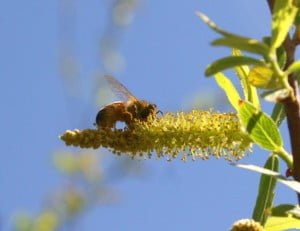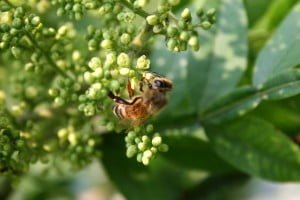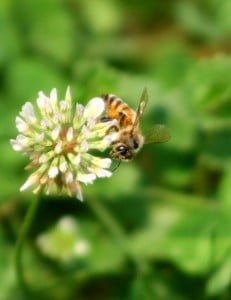 There is an emerging emphasis in our state, and probably all over the country, to “plant for pollinators”. Yet there are many people who are also enthused with planting for wild game. I was fascinated to discover recently that some excellent “bee plants” are also very important food sources for browsers and game birds. Here is a list of some of the plants that are important to deer, turkey, and grouse as well as bees. (Some information taken from American Wildlife and Plants; A Guide to Wildlife Food Habits by Alexander C. Martin, Herbert S. Zim, and Arnold L. Nelson.)
There is an emerging emphasis in our state, and probably all over the country, to “plant for pollinators”. Yet there are many people who are also enthused with planting for wild game. I was fascinated to discover recently that some excellent “bee plants” are also very important food sources for browsers and game birds. Here is a list of some of the plants that are important to deer, turkey, and grouse as well as bees. (Some information taken from American Wildlife and Plants; A Guide to Wildlife Food Habits by Alexander C. Martin, Herbert S. Zim, and Arnold L. Nelson.)
Maples: Maples can provide 25-50% of the diet of whitetail deer in much of the northeast. It is also a good source of food for Ruffed Grouse in winter. As a bee plant, Red Maple bloom comes to the rescue of winter-weary bees in early spring when bees need it the most. It is the earliest significant source of protein, kick-starting the population in preparation for the big nectar season that comes later. Other species of maples such as Sugar Maple and Silver Maple bloom a little later and are very high quality forage. In most of West Virginia, maples are already abundant.
 Willow: Fall through spring, deer can get 5-10% of their forage from willows. Ruffed Grouse can also get 5-10% of their diet from the buds and leaves of willow in winter and spring. Willows make an excellent early spring source of both nectar and pollen for pollinators. If you have a wet area or stream bank that needs planted or reclaimed, willows would make a great choice. They can thrive in places too wet for other trees.
Willow: Fall through spring, deer can get 5-10% of their forage from willows. Ruffed Grouse can also get 5-10% of their diet from the buds and leaves of willow in winter and spring. Willows make an excellent early spring source of both nectar and pollen for pollinators. If you have a wet area or stream bank that needs planted or reclaimed, willows would make a great choice. They can thrive in places too wet for other trees.
Blackberry and Raspberry: A good source of food for deer, turkey, bobwhite, and grouse, especially in summer. Anyone who tries to grow berries knows how much the deer love to browse the leaves and shoots, and how much the birds enjoy the berries. In addition, the growth habit of brambles provides perfect nesting and resting cover for game birds. Blackberry and Raspberry are major honey and pollen-producing plants.

The bloom time of the winged sumac variety is especially beneficial to bees. Note the “winged” or “webbed” leaf stem between the leaflets.
Sumac: An important winter source of food for deer, turkey, bobwhite, grouse, and other wildlife throughout the east. The seeds remain on the upright stems and are not covered up by deep snow. There are three common types, Staghorn, Smooth, and Winged, and all three are relished by pollinators. Winged Sumac is especially important as an abundant source of bee pollen in the summer dearth when other blooming plants are scarce in West Virginia.
Holly: With berries persisting through the winter, and leaves that are evergreen, holly is a source of food for wild turkey in winter and spring, and found to comprise 5-10% of the whitetail diet from fall through spring in North Carolina. We have tried growing holly where the deer population is heavy, and they keep it eaten down, especially when the snow is persistent. Holly is a good honey plant, producing an excellent light colored honey that is very slow to granulate, but in West Virginia the plants are not numerous enough to produce a surplus, and whatever honey is gathered is mixed with that of other plants blooming at the same time.
 Clover: Various clovers are often planted for the specific purpose of attracting and nourishing healthy deer. Clover can be a major food source for Ruffed Grouse, depending on the abundance of the plant, and is also eaten by turkey in summer and fall. I probably don’t need to say much about clover’s value as a honey plant. However, it is scarce in West Virginia and would be a good choice for planting, providing good forage in the summer dearth.
Clover: Various clovers are often planted for the specific purpose of attracting and nourishing healthy deer. Clover can be a major food source for Ruffed Grouse, depending on the abundance of the plant, and is also eaten by turkey in summer and fall. I probably don’t need to say much about clover’s value as a honey plant. However, it is scarce in West Virginia and would be a good choice for planting, providing good forage in the summer dearth.
Buckwheat: When available, buckwheat makes an excellent source of food for both wildlife and bees. Buckwheat honey is extremely dark, especially rich in antioxidants, and important for its therapeutic properties.
Basswood (Linden) and Sourwood both comprised 2-5% of whitetail diet in some locations. While they are usually only minor sources of forage, providing a bit of diversity to browsers, I felt they were worth including since they are such excellent honey plants. Basswood and Sourwood produce some of the highest quality honey, and beekeepers seek out locations where the trees are abundant.

great info. I’m in the process of sowing and planting for at least a 3 season food for my bee’s I’ve planted 150# clover have lavunder and have 50# buck wheat to sow later in the year got any more sug.that will help me I’d appr.any help thks
Hi Okey, I applaud your efforts. Plant pollen keeps Honey Bees healthy by providing protein and most of the other essential nutrients they need. Check out the WV Pollen Project report posted Dec. 29. There are Pollen Importance Tables toward the end of the report that show which species are most valuable to honey bees in regard to providing pollen.
One suggestion I would give is Chestnut trees. I don’t know if planting trees would fit into your plan, but not only are they extremely valuable to wildlife, but they provide quality pollen at a time that it would be of great benefit to bees. Basswood and various Milkweeds bloom at the same time as Chestnut, but fail to provide the pollen bees need. Seedling chestnut trees aren’t too expensive.
Another interesting find is that honey bees seem to get a lot more pollen from sweet clover than from white Dutch clover, even when the white is much more abundantly available. Sweet clover may require some liming to thrive, but is excellent for providing both honey and pollen for a lengthy period in summer.
The report only covers March through June pollen plants. Hopefully we will be able to produce a similar report focusing on July through October pollen sources by this time next year.